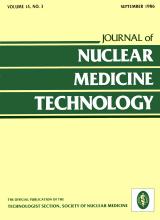Abstract
This study examines the physiologic and clinical validity of a new radionuclide angiographic (RNA) technique for assessing regional left ventricular (LV) dysfunction. This technique uses time-activity curves from normal and abnormal regions of interest to identify sites of passive myocardial dyskinesis (i.e., early-systolic bulge and early-diastolic shortening or recoil). A quantitative RNA image of early-systolic bulge was created by subtracting the end-diastolic frame from the frame with maximum counts (defined by the abnormal region); an image of early diastolic recoil was created by substracting the frame with minimum counts (abnormal region) from the end-systolic frame. These RNA indices of regional dysfunction were first validated in 12 closed chest dogs subjected to acute coronary artery occulsion and varying loading conditions; the RNA data correlated highly with direct ultrasonic crystal recordings of myocardial early systolic bulge (mean r = 0.93) and early diastolic recoil (mean r = 0.86). Subsequently, RNA studies performed in 36 consecutive patients who had cardiac catheterization for presumed coronary artery disease were interpreted visually and by RNA bulge and recoil analysis. Contrast ventriculograms were interpreted visually and quantitatively by shortening of 100 chords. Of 86 wall segments that were normal by chord shortening, visual interpretation of contrast and RNA studies was correct in 79% and 78% of the studies, while RNA bulge/recoil analysis was correct in 93% (p = 0.028 for this difference in specificity). Of 22 quantitatively abnormal segments, visual interpretation of both contrast and RNA studies was correct in 82% of the studies, while RNA bulge/recoil analysis was correct in 68% (p = 0.09 for this difference in sensitivity). This method for RNA assessment of regional LV dyskinesis is physiologically valid, objective, applicable clinically, and ideal for serial quantitative evaluations.
Footnotes
↵Editors Note: This manuscript received the first Editorial Technologist Award given by the Education and Research Foundation, the Society of Nuclear Medicine. The monetary award was made possible by donations to the E&R Foundation.







